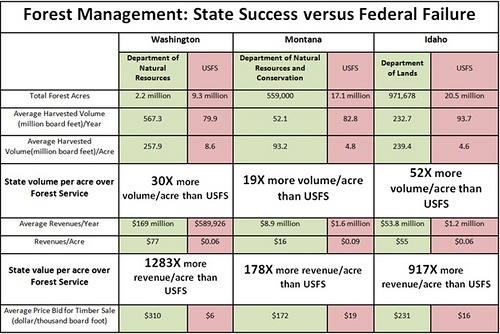2 min read
What States Can Teach the Federal Government about Forest Management
LeAndra Spicer : February 28, 2013

The House Subcommittee on Public Lands and Environmental Regulation heard from state leaders, land managers and forestry experts on the inadequacies of current federal forest management practices in February. Compared to state-managed forests, federal forest lands produce significantly less revenue despite their much larger land base. In addition, state forests across the nation spend less money on management yet consistently outperform federally managed forests in regards to board feet harvested and overall revenue production.
Subcommittee Chairman Rob Bishop referred to the federal government as an “absentee landlord” of more than 600 million acres of forestland and called for a “paradigm shift” to address and correct mismanagement. “Over the last few decades, we’ve seen our National Forest System fall into complete neglect—what was once a valuable asset that deteriorated into a growing liability. It’s time for the federal government to…start leveraging those lands in a way that benefits rather than burdens the taxpayers and communities who are forced to play host to the federal estate.”
Natural Resources Committee Chairman Doc Hastings noted his home state of Washington realizes average annual revenue of $168 million from just over two million acres of forest land. The U.S. Forest Service, on the other hand, manages over nine million acres of forest land within the state but yields only an average $589,000 in revenue each year. The following table highlights the state versus federal record in just three states:
Fellow Washington resident Lee Grose and member of the Washington State Board of Natural Resources told the subcommittee National Forests contributed “less than $1 per acre of revenue to the Federal Treasury” in 2011. The belief among industry experts is these same forests are capable of producing thousands of dollars per acre.
The subcommittee also heard from Wisconsin logger and American Loggers Council representative Matthew Jensen. Mr. Jensen noted, “Timber harvests from federal lands have declined by more than 80% over the last two decades.” The economic impact of such declines have led to loss of jobs and suppressed job creation in sectors both directly and indirectly related to timber. He estimated these impacts have reduced logging business by 30 percent.
During the hearing, Idaho Governor Butch Otter suggested the federal government place a portion of its forest lands into a “National Forest Trust” modeled after state management practices. The model would provide clear objectives and remove the cloud of confusion decades of statutory and regulatory changes have lent to present management frameworks.
Economic factors are not the only consideration. In addition to the negative impact poor forest health has had on communities located near National Forests, healthy forests are less susceptible to devastating wildfires.
Though it remains uncertain where just what action legislators will take, it is clear the federal government will need to follow the lead of the states to reestablish proper forest management. A webcast of the hearing is available on the Natural Resources Committee website.




